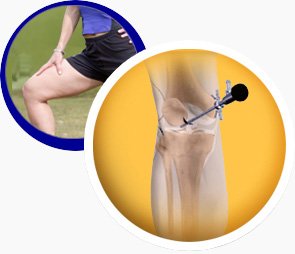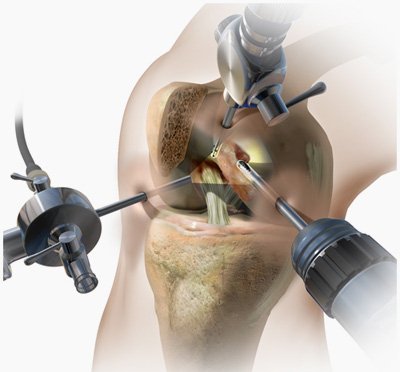|
 Knee
arthroscopy is a common surgical procedure
in which the knee joint is viewed using a
tiny camera. This procedure allows the
doctors to have a proper view of the
inside of the knee accordingly helping
them to diagnose and treat the problem. Knee
arthroscopy is a common surgical procedure
in which the knee joint is viewed using a
tiny camera. This procedure allows the
doctors to have a proper view of the
inside of the knee accordingly helping
them to diagnose and treat the problem.
With technical advancement and the
availability of advanced HD monitors and
HRD cameras these days, arthroscopy has
proved to be a very efficient tool to
treat any kind of knee problems. A survey
done by the American Orthopedic Society
for Sports Medicine suggests that a total
of 4 million arthroscopies take place
every year
1) DESCRIPTION -
Arthroscopy is
done by making small incisions into the
body. An orthopedic surgeon inserts the
arthroscope into the knee joint, which
sends photographs to a monitor. The
surgeon is now able to see the knee
structure minutely in the monitor. The
doctor can repair and remove any damage
tissue if required by making other
incisions around the knee and inserting
small surgical instruments.
2) PREPARING FOR THE
SURGERY -
 If you are
suggested to go for knee arthroscopy
surgery, you would require getting a full
body checkup done by your family physician
before the operation. He would assess your
physical condition and suggest accordingly
if there is anything that could interfere
with the surgery. If you are
suggested to go for knee arthroscopy
surgery, you would require getting a full
body checkup done by your family physician
before the operation. He would assess your
physical condition and suggest accordingly
if there is anything that could interfere
with the surgery.
It is also important for you to let your
surgeon know about any medicines or
supplements that you are taking. He may
have something to say and may ask you to
stop or start certain medicines. It is
also possible that he runs a few
pre-operative tests on you including EKG
or blood counts.
3) WHEN KNEE
ARTHROSCOPY IS SUGGESTED?
Knee
Arthroscopy is mostly suggested for:
Repair or removal of torn meniscal
cartilage
Trimming of torn pieces of articular
cartilage
Reconstruction of a torn anterior
cruciate ligament
Removal of inflamed synovial tissue
Removal of loose fragments of bone or
cartilage
4) COMPLICATIONS AND
WARNING SIGNS -
As with any
kind of surgery, knee arthroscopy also has
its own share of risks involved. However,
the chances are quite low and mostly minor
and easily treatable.
 Complications Complications
Blood clots
Infection
Accumulation of blood in the knee
Warning Signs - Get in
touch with your surgeon immediately if any
of the following is experienced:
Chills
Fever
Persistent redness and warmth around the
knee
Increased or persistent pain
Swelling in your knee
Growing pain in the calf muscle
5) OUTCOME
Apart from a
ligament reconstruction surgery, any knee
arthroscopy patient can get back to doing
regular physical activities after 6 to 8
weeks and sometimes even sooner. However,
activities requiring much physical
strength need to be avoided for a longer
period. You ought to talk to your surgeon
to know when you can start intense
physical activities.
The final result of the surgery would very
much depend on the degree of damage to
your knee. For instance, if the articular
cartilage in your knee has completely worn
away, it is not possible to get full
recovery. Moreover, you need to make
changes in your lifestyle, which means
limited physical activities and doing
low-impact exercises.
|